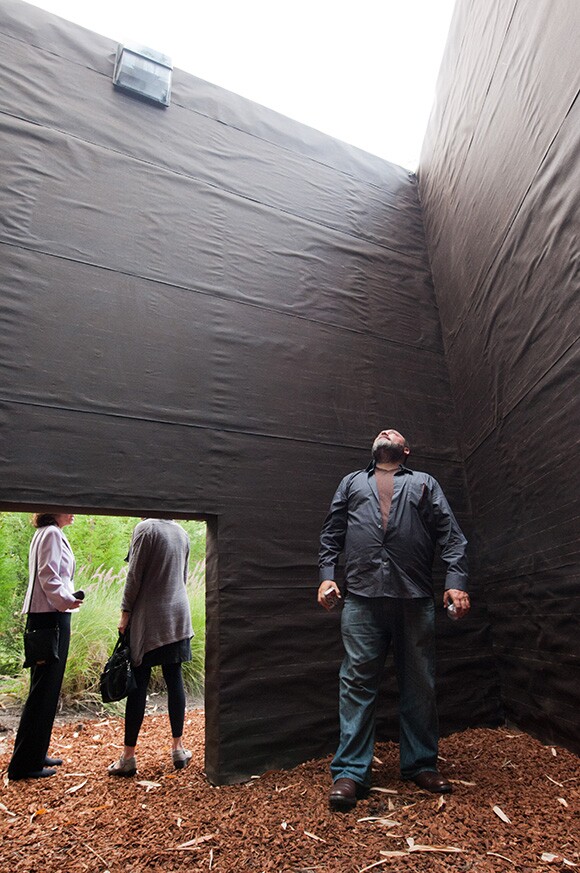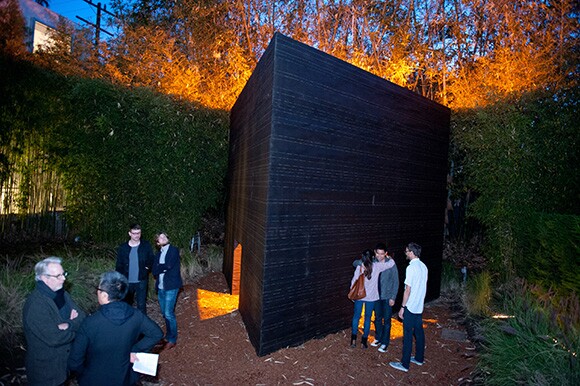Architectural Sculpture: Bruce Nauman's 'Untitled (Equilateral Triangle)'
Ever since the Getty's initiative Pacific Standard Time Presents: Modern Architecture in L.A. kicked off in April and continued all spring and summer with nearly a dozen exhibitions and dozens more programs and events across Los Angeles institutions, there's been a conversational buzz. At openings, on panel discussions, and in reviews those murmurs have been less about celebrating any particularly iconic buildings in the city and more about the dialogues, blurred boundaries, and differences between art and architecture.
Perhaps it's a perennial question that always arises when architecture hits the gallery, or perhaps it's an afterimage from the art edition last year, but the PSTP shows, with a few exceptions, break down into two disciplinary camps: L.A. architecture through an urbanism lens and L.A. architecture through an art lens. The latter includes Los Angeles County Museum of Art's two entries, "The Presence of the Past: Peter Zumthor Reconsiders LACMA" and "Stephen Prina: As He Remembered It." Each is a tactful conversation starter. The scheme by Swiss architect Peter Zumthor is indeed architecture for an art museum, however bold and black. Prina's installation, on the other hand, softens the boundaries.
Prina, a Los Angeles-based artist, created a series of mnemonic sculptures based on a fragment of a Rudolph Schindler residence he saw while walking down La Brea in the 1980s. His installation consists of 28 Pepto Bismo pink objects -- recreations of built-in furniture and cabinetry from two of the houses designed by the Austrian émigré architect. L.A. architects Frank Escher and Ravi Gunewardena collaborated with Prina on the research and fabrication of the artworks. (More on Prina's work here.) The architects from both eras act in service of the artist's conceptual vision. Prina's recollections, then, tie together two generations of architects, as architecture from the early part of the 20th century is translated into art for the 21st.


But things get lost in translation, as illustrated by the contention around MOCA's "A New Sculpturalism: Contemporary Architecture from Southern California" exhibition across town -- a show broken by egos and institutional politics. The strife began, and perhaps ends, with the title. By seemingly reducing architectural production down to formal objects akin to sculpture, curator Christopher Mount set in motion the chain reaction that saw architect Frank Gehry leave and then return to the show and, ultimately, put the exhibition in the hands of architect Thom Mayne.
In his catalog essay entitled "The Foundation of A New Sculpturalism," Mount spells out his reasoning for poaching potentially problematic verbiage from the fine arts. And given the mutation of the MOCA exhibition, it is one of the few places to find glimpses of original intent. He writes, "'Sculptural' is applied in this instance as a way of expanding the nomenclature of architecture; it signals an opening up of possibilities, nodding to the diversity that has been successfully promulgated by recent generations of Los Angeles practitioners." In the end, unfortunately, the terminology had the opposite outcome; it produced an internal, singular dialogue. The most telling act of displeasure with the title is found on a banner at the MOCA Contemporary's entrance. Graphic designer Willem Henri Lucas updated Michael Worthington's original logo for the show by scrawling out the words "A New Sculpturalism."
At the MAK Center for Art and Architecture at the Schindler House, "Everything Loose Will Land," academic and curator Sylvia Lavin's contribution to Pacific Standard Time Presents, looks exactly at this unruly intersection of art and architecture over a time period from the mid-1960s through the early 80s. Meticulously researched, the confluences between the two disciplines play out across the shows four rooms: Environments, Users, Procedures, and Lumens. For example, pencil sketches and floor plans by Gehry of Ed Ruscha's house from 1977 are less interesting as virtuosic drawings than as documents of an authorial struggle. An accompanying text explains that although Frank O. Gehry Associates produced the working drawings, Ruscha considers himself the designer. Which leads one to wonder if the Ruscha house files under Sculpture or Architecture.

"Everything Loose Will Land" willfully engineers these kinds of questions--quite literally, too. Built on the Schindler House grounds is "Untitled (Equilateral Triangle)" by Bruce Nauman. The sculpture is neither a relic nor a replica of the artwork Nauman erected on the Caltech campus for the 1980 exhibition "Architectural Sculpture."
"Architectural Sculpture actually wasn't about the intersections between architecture and sculpture. It was about sculpture behaving like architecture or taking on architectural concerns," says Lavin of the earlier exhibition. "And from that point of view, of all of the Naumans, this one is the most fulsome in its occupation of a traditionally architectural situation: Outdoors, freestanding, enterable, made out of architectural materials, etc."
Working from Nauman's handwritten notes and small axonometric sketch showing the placement of the lights on the inside (from the Friedrich Christian Flick Collection), architects Mark Lee and Lindsay Erickson of JohnstonMarkLee oversaw the construction documents and permitting of the sixteen-foot-high outdoor object covered in black asphalt paper. The JohnstonMarkLee team pulled building permits for the temporary structure and worked with both a contractor and structural engineer. (There's a triangular concrete foundation supporting the artwork.) Nauman didn't want his instructions exhibited, however, raising the problem of not only what exactly is the artwork, but also when exactly is the artwork. It exists in two times: 1980 and today.
For MAK Center director Kimberli Meyer the conversation around the building of "Untitled (Equilateral Triangle)" highlights some of the essential differences between the disciplines. "It's typical with artists, they don't want the drawings shown because that's process, not the final thing," she explains. "Whereas architects don't mind if you show the drawings, but yet, the artist was fine with us rebuilding this work to the specifications. We worked closely with the Nauman studio on this, but I don't know that many architects who would say: Yeah, go rebuild my building."
Nauman's sculpture sits in the sunken ivy bed in the garden behind the historic Schindler house. Its placement required negotiations with The Friends of the Schindler House, the group that supports the preservation of the 1922 building, so that the artwork would not be seen from the street, detract from the residence's significance, or in anyway threaten the home's integrity. An exciting dialogue exists between the Nauman's monumental artwork and Schindler's architecture, with its low-slung profile and porosity between inside and outside. "I would never have put Nauman and Schindler in the same breath," says Lavin. "I would never have imagined that there was a relationship between the two, but in fact, it turns out that there is a really significant way of understanding site and building process, construction, informality, the pinwheel plan and all kinds of things."

"The Nauman is significantly proximate to a set of architectural habits that found their locus in L.A.," Lavin continues, noting the similar use of off-the-shelf materials, squat proportions and blocky geometry that are used not only on Schindler's architecture, and thus Prina's pink-hued artworks, but also in projects by Gehry, Eric Owen Moss, and Morphosis -- architects featured in "A New Scupturalism." The proximity is provocative, asking the viewer to re-calibrate their understanding of both architecture and art production. An interesting outcome of this particular conversation brought about by Pacific Standard Time Presents is how it loops back on itself, covering ground from mid-century, the seventies, and today. The cross-pollination between disciplines in Los Angeles, expressed as tensions, adjacencies, influences, memories, and collaborations in the summer's exhibitions, underscores a co-mingled history and shared geography.
Dig this story? Sign up for our newsletter to get unique arts & culture stories and videos from across Southern California in your inbox. Also, follow Artbound on Facebook and Twitter.